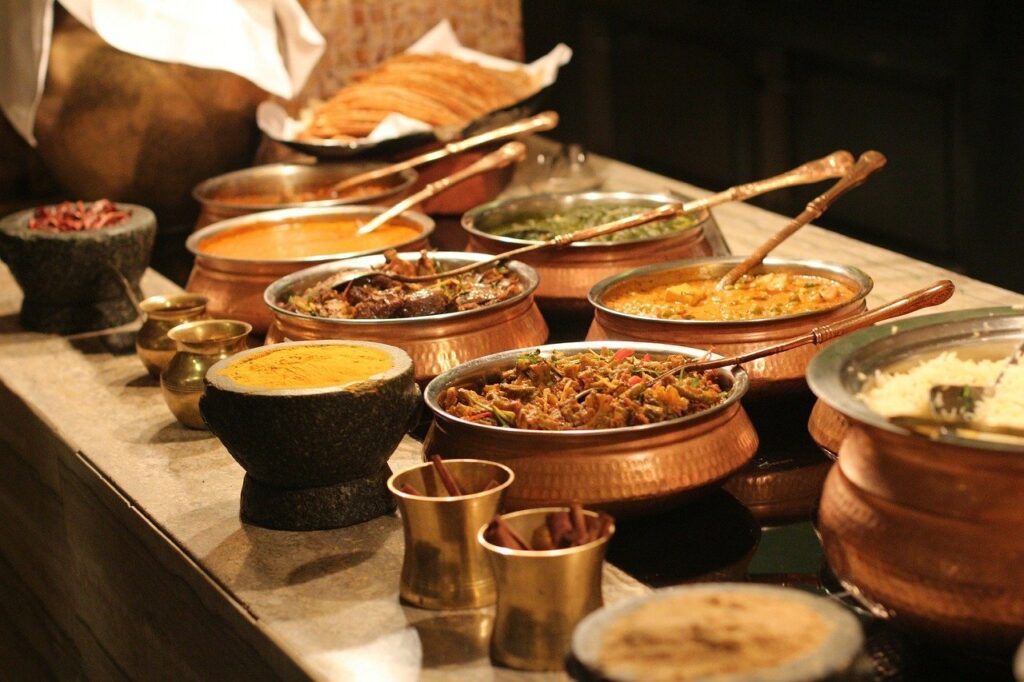The Indian food at which we look today was not the same in the past. It has gone through drastic transformations several times. Every time a traveler visits our sacred land, he left only after altering our tastes a bit. This repetitive influence of foreigners made Indian food the rich amalgam which it is now.

Cultivation of lentils(dal), wheat (flour), rice, pearl millet (bajra), vegetables, fruits, grains and dairy products started from 6200 BCE, in the Indian subcontinent. These are the foundation of numerous food which we eat today such as roti (Indian bread), tadka dal, vegetable curry.
One of the very first foreign influences that Indian food experienced was after the failed attempt of Alexander of conquering India. Therefore, he was the first one to initialize the change in Indian food.
Influence of Greeks
Greeks brought with them various fresh herbs such as oregano, mint, coriander, and essential oils such as olive oil. They had also brought spices such as Saffron, fenugreek, fennel.
Did you know, Greek cuisine is still famous for its fruits, nuts, grains, cheese, and oils? If not, then let me tell you, it is. They also brought vegetables with them like eggplant and zucchini. The influences of Greek is still visible on the Indian cuisines — kalhari from Jammu.
Influence from Mughals
The integration of Indian food with that of Mughals made it into meaty and juicy. The Muslims from western Asia had brought the rich heritage of Mughlai cuisines. Mughals with all their grandeur of architecture music and dresses.
They influenced Indian traditions to a large extent. Mughals brought with them the use of aromatic spices such as cardamom, mace, nutmeg, and a variety of nuts such as almonds and pistachios. The cooking style also changed with the advent of spitfire roast. This gave birth to various kebabs and tandoori food.
Their spices were exquisite and exotic. Moreover, the usage of milk and cream gave birth to pilafs and biryanis.
The meat was the main ingredient of Mughal food, unlike traditional vegetarian food. The interference of Mughals gave birth to amazing cuisines which are still enjoyed by the natives such as Lucknowi kabab and Hyderabadi biryani.
Impact of China
The Mongolian and Chinese had an influence on the Indian food of northeastern states such as Mizoram, Arunachal Pradesh, Nagaland, and Manipur. These states are influenced by Mangolian practices of hotpots and stews. It is the Mongolian influence only which did make rice their staple food in northeastern states. They brought simplicity to Indian food.
The use of mincemeat in dumplings is widely practiced in northeastern states. They are cooked in hotpots; therefore, various food items possess soupy texture.
The momos are a modern dish that is inspired by this style of cooking. The practice of steaming and frying is an influence of this type of cooking. Mustard oil and sugar were introduced by Mongols and are the cause of various varieties of sweets that the northeast especially Bengal is famous for. The Kadai stir is also influenced by the Chinese wok.
Influence of Britishers in Indian food
They brought with them the flexibility and diversity of the European style of cooking. The practices of frying on cast iron pans were introduced by them. Moreover, grilling was also one of their habits. They had brought amazing cooking styles to India.
One of such many examples is the concept of serving curries with rice in India and the practice of preparing dishes such as Murgh makhani to India. Many Britishers considered Butter Murgh Masala as their national dish.
The concept of soup was unheard of in the Indian subcontinent before the European influence on Indian cooking style.
They also introduced whiskey and tea to India. They also introduced the practice of baking cakes to Indians. Our morning biscuits, eaten with a cup of tea, are also an influence of the Europeans.
Influence of Portuguese
The influence of Portuguese could be seen in the colony of Goa. It is a hub of various seafood and wine. Their influence made a tangy spicy flavor the specialty of Goan food. The introduction of seafood such as prawns and meat such as Pork and Beef is also an influence of Portuguese culture. They brought with them fruits, such as cashews nuts, tomatoes, pumpkins, pineapples, guavas and passion fruits, from the tropical Caribbean island.
Conclusion
Indian food has a massive interactive history with foreigners, which is the only reason for India’s richness in food culture. Of course, no food-culture gain such flavors overnight. It is the result of India’s history and heritage of Vasudhaiva Kutumbakam.
